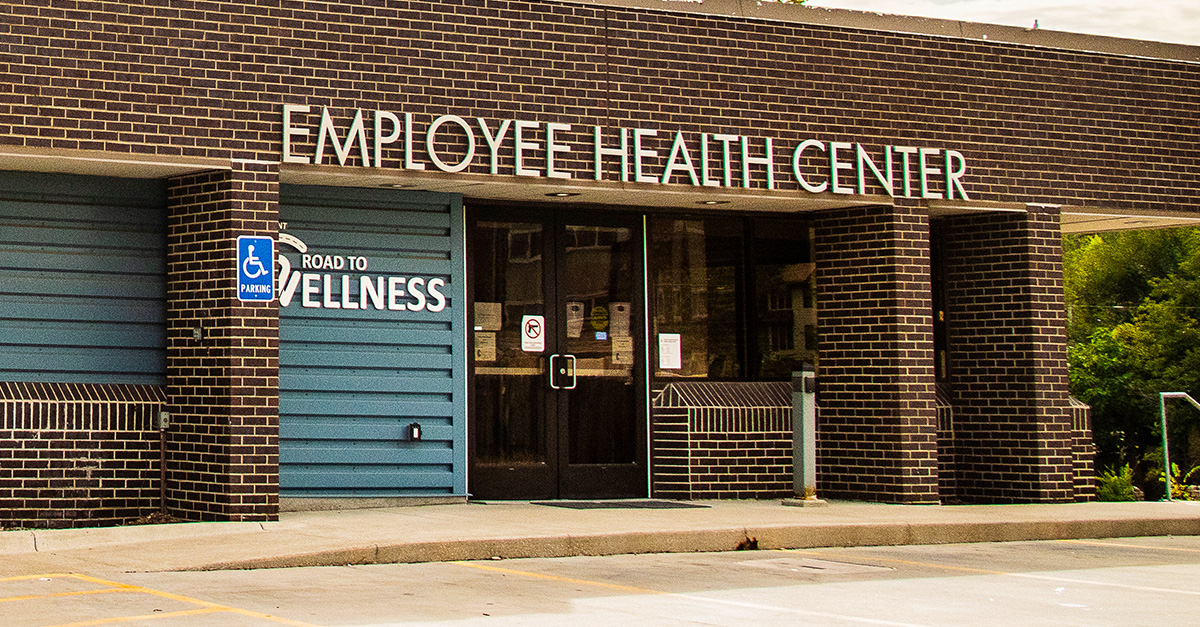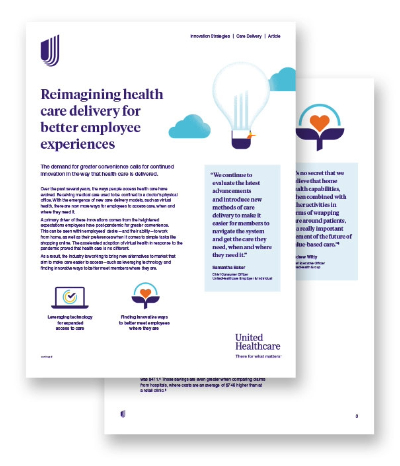Reimagining health care delivery for better employee experiences
The demand for greater convenience calls for continued innovation in the way that health care is delivered.
Over the past several years, the ways people access health care have evolved. Receiving medical care used to be confined to a doctor’s physical office. With the emergence of new care delivery models, such as virtual health, there are now more ways for employees to access care, when and where they need it.
A primary driver of these innovations comes from the heightened expectations employees have post-pandemic for greater convenience. This can be seen within employees’ desire — and their ability — to work from home, as well as their preferences when it comes to simple tasks like shopping online. The accelerated adoption of virtual health in response to the pandemic proved that health care is no different.
As a result, the industry is working to bring new alternatives to market that aim to make care easier to access — such as by leveraging technology and finding innovative ways to better meet members where they are.
“We continue to evaluate the latest advancements and introduce new methods of care delivery to make it easier for members to navigate the system and get the care they need, when and where they need it.”
Leveraging technology for expanded access to care
The shift to remote working models became a necessity in 2020 as companies scrambled to redefine business as usual and ensure employee safety during a global pandemic. Nearly 3 years later, about 2 in 5 employees still work from home full-time or in a hybrid capacity.1
This may explain the popularity of virtual health visits, wearable tech-based medical devices and digital health care tools — all of which help make it easier for employees to access care from home or on the go. Some employees may not be comfortable with in-person visits, some live in rural communities that have fewer providers or health care facilities, while others may face challenges related to social determinants of health (SDOH) such as lack of transportation. That access to care matters.
Virtual visits — whether for physical or mental health care — allow employees to meet with a provider to discuss nonemergent health concerns without having to leave the comfort of their own home or even their workplace. While it may be determined that an in-person follow-up is needed, these initial visits can often reduce provide, payer and patient costs.2
Wearable devices that use biosensors — like watches that track physical activity, sleep patterns and even heart health, or glucose monitors that offer an alternative to finger sticks for managing diabetes — can deliver real-time data to health providers when linked to certain health apps. This data can help providers better understand a patient’s health status and give valuable insights to help inform care.
Digital tools — including apps like the UnitedHealthcare® app, allow members to search for providers, procedures and pricing estimates — giving them the power of choice in terms of how they want to receive care — where, with whom and at what cost.
Advancements in technology are transforming the way people access care by breaking down the barriers of the traditional brick-and-mortar model and to offer choices that extend beyond the borders of an employee’s ZIP code.
Meeting employees where they are
Beyond providing access through the click of a button, carriers are working to facilitate access to care to employees at their home, within the local establishments they frequent, in their community or at their workplace.
Investing in the future of home-based care
UnitedHealth Group — the parent company of UnitedHealthcare and Optum — foresees home-based care playing a critical role in the future of health care delivery.
Delivering care within an employee’s home environment can allow providers to evaluate that individual’s health status more accurately and identify any barriers related to SDOH that may be preventing them from getting the care they need. The result is potentially better health outcomes and lower costs, in addition to a simpler and more convenient health care experience.
UnitedHealth Group recognizes that working with others is essential to bringing the best possible home health solutions to market. For example, Optum is teaming up with Amedisys, an in-home care provider, to combine and increase their capabilities. Amedisys annually provides in-home care to more than 465,000 people with complex or acute conditions,3 helping them to potentially avoid more costly care options such as hospitalizations and emergency room visits. This collaboration is an example of the many significant investments being made in the home health space.
“It’s no secret that we believe that home health capabilities, when combined with other activities in terms of wrapping care around patients, is a really important element of the future of value-based care.”4
Leaning into the convenience of non-traditional sites of care
It’s important to find ways to bring care to where employees are. Having multiple care access points may lead to better overall health outcomes.
In fact, the amount of health services conducted through retailers like grocery stores, large pharmacies and big box stores was predicted to have doubled by 2023.5 Services offered can include blood tests, medical checkups, vaccinations and other biometric screenings.
Karen Silgen, vice president of product for UnitedHealthcare Employer & Individual, explains what’s driving the shift to retail: “We’re seeing more members choosing nontraditional site of care, like retail clinics, out of convenience. They offer more flexible accessibility than traditional providers, which can be attractive to employees seeking care outside of normal work hours.”
In addition to convenience, the average cost savings per claim when an individual received care at a retail clinic versus a doctor’s office was $471.6 Those saving are even greater when comparing claims from hospitals, where costs are an average of $746 higher than at a retail clinic.6
Bringing care to the workplace with on-site clinics
One way employers can help make it easier for employees to access care and meet them where they are is to establish an on-site health center or clinic. According to one survey, more than half of large employers are considering adding an on-site clinic by 2024 — a 44% increase from the start of the pandemic.7
On-site health centers — some of which include clinics, pharmacies, on-site nurses and workout facilities — can be an important part of an employer’s overall health plan strategy and can contribute to improved employee health, higher employee satisfaction, decreased absenteeism and lower costs for employers and employees.8

Taking an innovative approach to meeting employees where they are with an on-site health center
During its 20-year+ relationship with UnitedHealthcare, the Unified Government of Wyandotte County/Kansas City, Kansas, has pushed itself to think bigger when it comes to the health and well-being of its employees and the community it serves.
Building healthier communities
This concept also extends to the communities in which employers do business and employees live and work. Without access to nearby care, employees may be more likely to avoid or forgo care altogether, which may result in poor outcomes and higher costs for themselves and their employers.
Taking action to help ensure employees have access to the health services and care they need within their community matters. As part of its commitment to building healthier communities, UnitedHealthcare partnered with Fairview Health Services in downtown St. Paul, Minnesota, to help support the design and implementation of health care and social programming services at the Fairview Community Health and Wellness Hub. The Hub aims to target health disparities and remove barriers to care.
